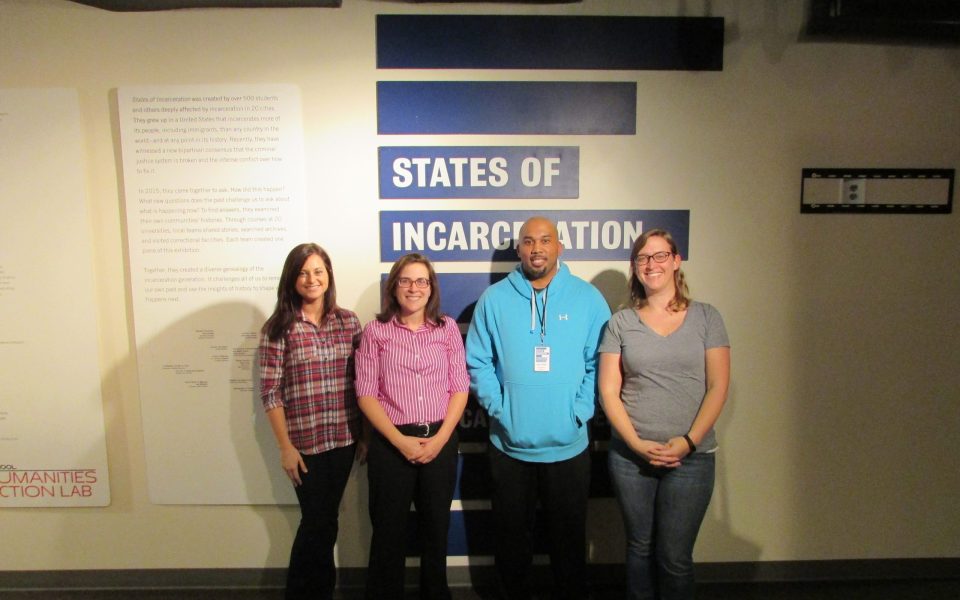Anne Parsons, director of the museum studies program at UNCG, didn’t anticipate that Donald Trump would be elected president on Nov. 8, the day the States of Incarceration exhibit opened at the International Civil Rights Museum in Greensboro.
“Under the Obama administration there was a real shift to de-carcerate prisons, both by increasing probation and shortening sentences, and by reviewing drug crimes,” she said during a tour of the exhibit on Monday. “In a lot of ways it was this positive moment. Now, a lot of that is up in the air. With stocks for private prisons rising after the election of Trump, there’s a question of whether incarceration will increase with the detention and deportation of immigrants.”
Organized and produced by the New School’s Humanities Action Lab in New York City, the exhibit brought together 20 universities to develop different sections of the exhibit. Parsons and her museum studies students researched the history of chain gangs in North Carolina, addressing the twinned questions: “Who works for prisons? Who do prisons work for?”
Through the State Archives of North Carolina and the Library of Congress, the students curated photographs and letters from inmates who worked on the chain gang to tell the story of the state’s system of racial exploitation through prison labor. State-controlled chain gangs were conceived as a progressive alternative to convict leasing and a means to build the state’s modern highway network in the 1910s, but the county-run labor camps used to administer the program were rife with abuse. By the ’20s, prisoners and their families were writing letters to North Carolina Gov. Thomas Bickett appealing for reform.
“These people say we are not human,” one prisoner wrote.
Another reported, “We are all sick and unable to work falling out on the road everyday working in the rain get wet can’t sleep at night.”
One of the most eloquent testimonials came from a man who wrote, “I am a Negro of good Christian family although I made a mistake in life does not call for the management of this camp to treat me and my race as dogs because he has been misled regarding the law.”
Not all of the prisoners were black, but the statistics of North Carolina chain gangs ring familiar with today’s state prison system. In the 1920s, only 31 percent of the state was black, but black inmates made up 68 percent of the chain-gang population.
“As students we got real attached to the people writing the letters,” said Leslie Leonard, one of the students.
The students also formed a bond with Lacy Colon, a formerly incarcerated individual who assisted as a consultant in the development of the chain-gang section of the exhibit. The respect and affection goes both ways.
“Most of the people on the inside don’t feel like anyone cares,” said Colon, who served time in prison from the age of 18 to 33 and came out in 2010. “To see that they care, that was huge.”
Although chain gangs were eventually discontinued, the state prison system still utilizes prison labor. As a juvenile offender, Colon said he worked in a program called “bootcamp” without pay, pulling weeds in a cornfield near Fayetteville and cleaning out horse stables. Later, as a prisoner in the adult system, he worked prison jobs that paid between 40 cents to $1 a day.
“They were sending letters to politicians pleading for reform,” Colon said of the chain-gang laborers of the ’20s. “That’s not the reason it stopped. The reason it stopped was because in the Great Depression they wanted to create jobs and they gave those jobs to people outside of the prison system.”
Sonya Laney, also a student in the museum studies program who helped design the exhibit, picked up the thread, noting that history doesn’t always have an inspiring refrain.
“We got attached to these nameless people, and as historians we want everything to end in a happy box,” she said. “That’s not the way it usually works.”
With Trump’s election, proponents of reform are harboring a faint hope while maintaining a realistic acknowledgement that racialized systems of control and exploitation might well be on the brink of a new mutation.
“The biggest fear I’ve seen is with immigration,” Colon said. “You have people saying, ‘Please adopt my kids in case I’m detained.’ We’ve talked about prison being the new slavery. If you have people who are illegal immigrants and their home countries won’t take them back, they might wind up being held in prison. Most likely, they’ll be put to work.”
Join the First Amendment Society, a membership that goes directly to funding TCB‘s newsroom.
We believe that reporting can save the world.
The TCB First Amendment Society recognizes the vital role of a free, unfettered press with a bundling of local experiences designed to build community, and unique engagements with our newsroom that will help you understand, and shape, local journalism’s critical role in uplifting the people in our cities.
All revenue goes directly into the newsroom as reporters’ salaries and freelance commissions.


Leave a Reply